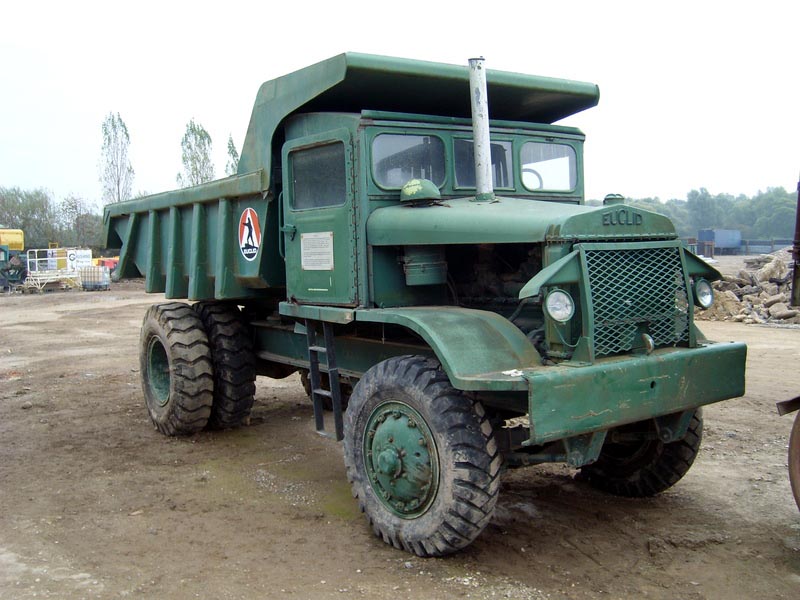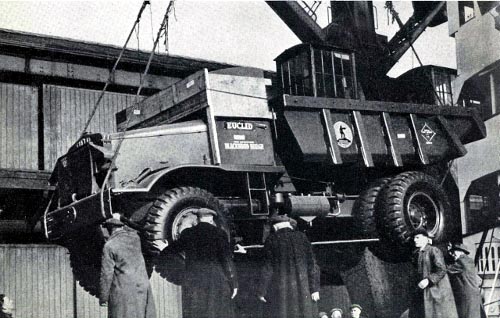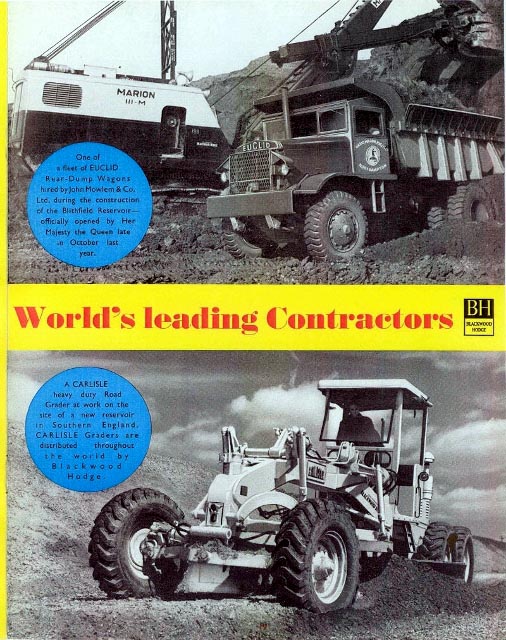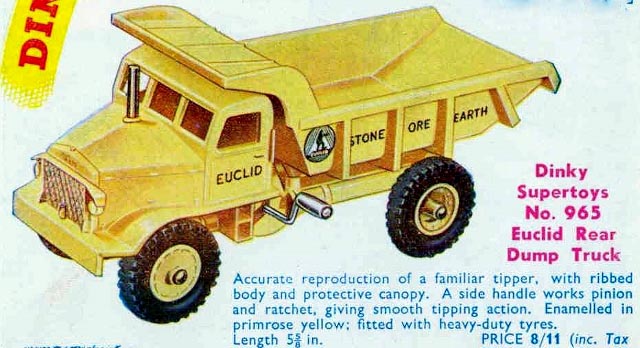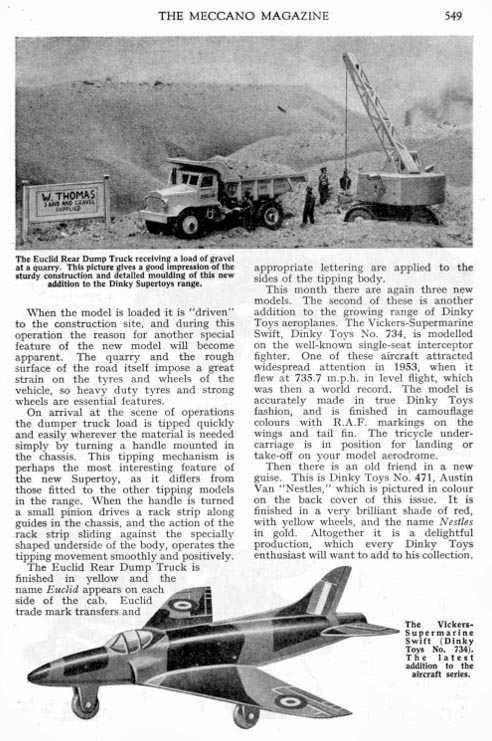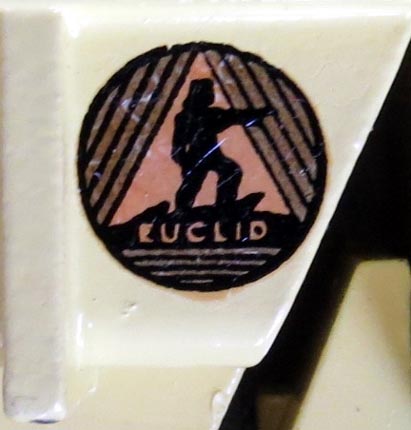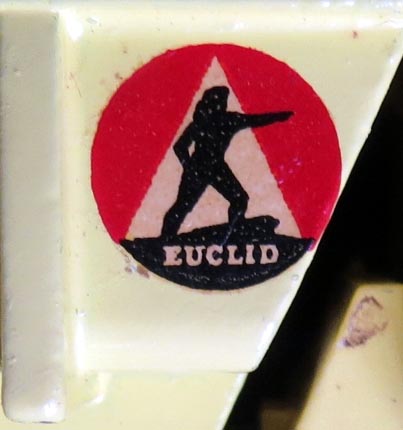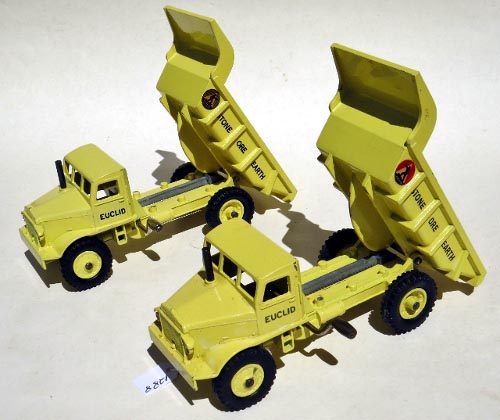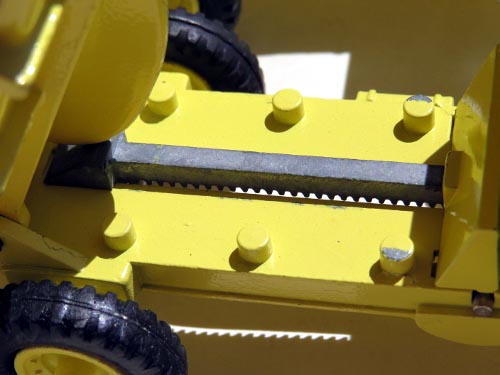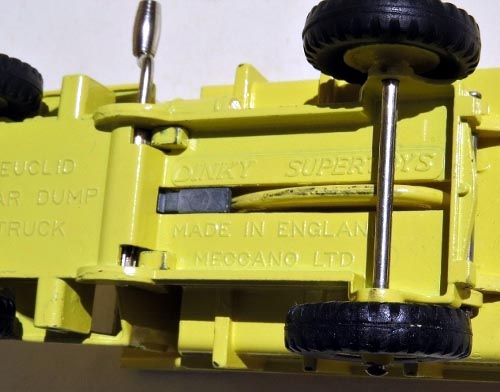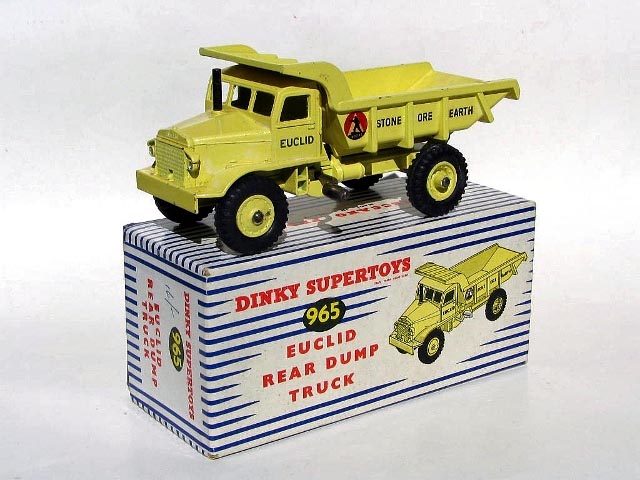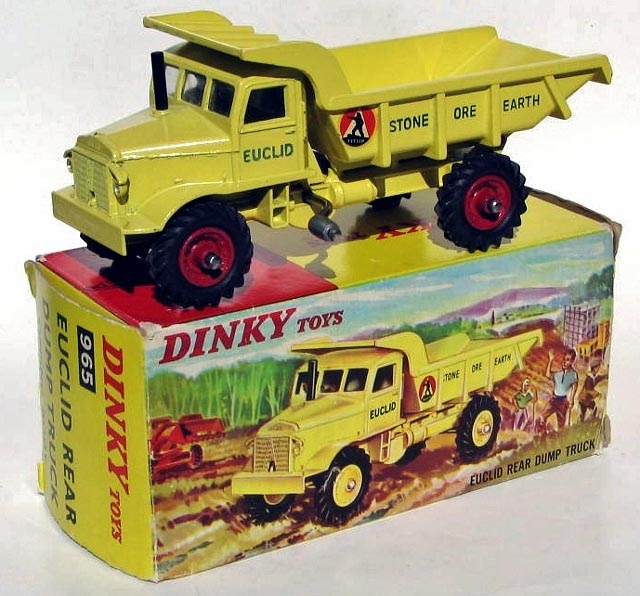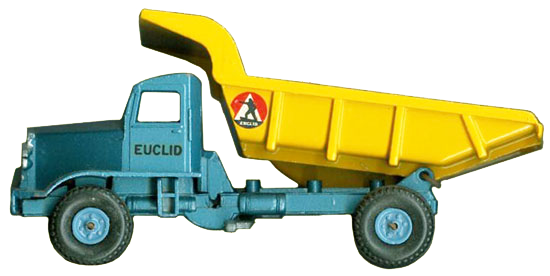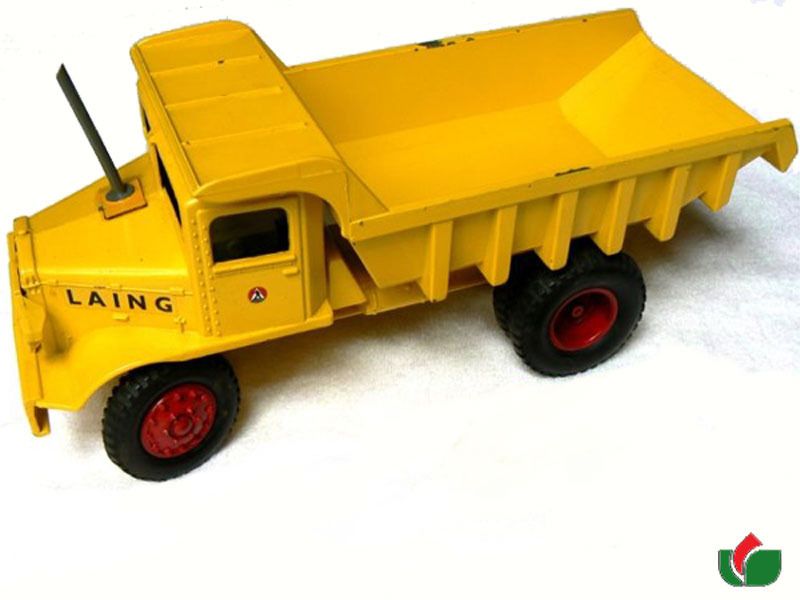- Thank you received: 0
965 Euclid Rear Dump Truck (1955-69)
10 years 8 months ago #16291
by starni999
Replied by starni999 on topic 965 Euclid Rear Dump Truck (1955-69)
Dinkinius wrote: 'The above quote is interesting without seeing exactly what was written in Diecast Collector, as I know of 'CANARY YELLOW' but have not heard of 'canary GREEN'. Canary green with a touch of green sort of does not sound right. Has anyone looked at my previous post with the picture of both the first and last models of the 965? There is a distinct difference, more noticeable under artificial lighting.' Hi Bruce, / all, Got to admit when I read this I thought 'that's a typo, it should read Canary yellow with a touch of green'. Chris Warr
Please Log in or Create an account to join the conversation.
10 years 8 months ago #16304
by Dinkinius
Replied by Dinkinius on topic 965 Euclid Rear Dump Truck (1955-69)
Greetings Chris and everyone I have finally located more information on the so-called 'Canary Green with a touch of green'! The colour is actually HILITE GREEN. The Following images are of the oldest Euclid R15 in the United Kingdom that has been fastidiously restored and has been displayed at a number of locations. This is the model Euclid on which Meccano based its 965.
Notice the colour matches the updated model next to it. However, this was not the correct colour for this truck when it was made, so the painter had to re-do his work, this time selecting PARKINSON GREEN.
The following is a photograph of the truck taken some years before its last refurbishment:
Finally, here is a photograph of a Euclid R15 on a Blackwood Hodge display at a trade fair, and although the image is not in colour, it shows the model in its Parkinson Green finish.
The subject of the reason Meccano chose an entirely different colour, a nice shade of yellow, will be explained in a later post. Kind regards Bruce
Please Log in or Create an account to join the conversation.
10 years 7 months ago #16305
by starni999
Replied by starni999 on topic 965 Euclid Rear Dump Truck (1955-69)
Thanks Bruce, Really good to learn more about this one, never one of my favourite Dinky's, (that HUGE handle just spoils it for me) but the real thing is actually very handsome isn't it? Pity Dinky didn't do that lovely shade of 'Canary Green' though, that would have looked excellent. Chris Warr.
Please Log in or Create an account to join the conversation.
10 years 7 months ago #16308
by janwerner
Replied by janwerner on topic 965 Euclid Rear Dump Truck (1955-69)
Very nice and high quality picture documentation Bruce, thanks! And still there is that unsolved initial question of mine ... Notably it's the same colour there, an ordinary repaint? But why playing with such a nice repaint in a sandpit? Kind regards, Jan
Please Log in or Create an account to join the conversation.
10 years 7 months ago #16333
by Dinkinius
Replied by Dinkinius on topic 965 Euclid Rear Dump Truck (1955-69)
buzzer999 wrote: 'There are two real world Euclid R15s within 20 miles of where I live, one is Green and the other Yellow as per the Dinky.
The Green one attends shows throughout the summer season, the Yellow one is at a quarry and is still a working vehicle - note the tipping mechanism is more faithfull to the Dinky. I live on the outskirts of Corby, this of course was a steelmaking town and 40 years ago Euclids were a common site as there were about a dozen belonging to British Steel. This was before I came to the area and I never saw them working here. Dave' Greetings Dave Regarding your above post (which I have edited to save space!) the yellow Euclid depicted has moved and is now being subjected to restoration, although I am uncertain whether the authentic winding mechanism is included as part of the project!! Bruce
As it was back then in October 2007, and
as it was in September 2010.
Please Log in or Create an account to join the conversation.
10 years 7 months ago #16381
by Dinkinius
Replied by Dinkinius on topic 965 Euclid Rear Dump Truck (1955-69)
Greetings all In the absence of an introduction into the Dinky Supertoys 965 Euclid Rear Dump Truck in this Thread, I thought it would be nice for collectors to read how the model came into being and some details associated with the actual truck on which the 965 is based, the Euclid company that manufactured it and the many changes that were made to the original 965 die over the years. I hope in the course of this dissertation, an explanation may be reached that satisfies the existence of a strange mid to dark green Euclid that was the original subject of this thread. The company that became Euclid was founded in 1907 in Wickliffe, Ohio, by George A. Armington as Armington Electric Hoist. It was renamed Euclid Crane & Hoist when the plant was relocated to Euclid, Ohio. Euclid built experimental tractors, one crawler and several wheeled, in the 1920s, and entered the construction equipment industry when it introduced the Automatic Rotary Scraper in 1924. Acceptance of the scrapers led to the creation of the Road Machinery Division in 1926, and the Division was incorporated as Euclid Road Machinery, a subsidiary of the Euclid Armington Corp., on July 11, 1931. Euclid Road Machinery became independent of Euclid Armington on January 1, 1933, and no record is known to exist of Euclid Crane & Hoist after this. Euclid Road Machinery introduced a variety of allied equipment for crawler tractors, but its biggest breakthrough came with development of the first true off-highway end dump and bottom dump trucks in the mid 1930s. Euclid came to dominate the market with these vehicles to the point that Euc came to be used generically for them. Euclid expanded with overseas branches and began production of trucks and scrapers in Motherwell, outside Glasgow, Scotland, in January 1951, with the Euclid R-15 followed by the R-22 in October 1953.
The Euclid factory in Scotland shipped countless R-15 Rear Dump Trucks as well as Euclid scrappers etc. The following are some images showing the despatch of a number of R-15s from the factory to the wharf in Glasgow with their ultimate destination being Angola in south-west Africa.
In the years following the end of the Second World War, Britain pioneered equipment rental, and one such company that later established branches all over the world, was Blackwood Hodge. This company that had been importing agricultural machinery was appointed the agent of the Euclid Road Machinery and set about developing a large facility in Northampton, from which to sell, hire and service Euclids large earth-moving equipment, in particular the Euclid R-15 Rear Dump Truck. Blackwood Hodge commenced exporting large quantities of Euclid R-15 rear dump trucks to many countries including Angola, Iraq and Saudi Arabia. In Australia the company established offices that handled the importation of the products from the Scottish plant which later handled the purchases of Euclid products, in particular tghe Euclid R-15 made by Mary Kathleen Uranium Mine in Queensland and the Snowy Mountains Authority in New South Wales. On the domestic front, many smaller quarry and construction companies could not afford to purchase large equipment such as the R-15, until Blackwood Hodge brought affordability into the equation by setting up a division that hired out earthmoving vehicles, in particular the R-15. The division was called Euclid Wagon Hirers Ltd.
During this time in the early to mid 1950s, Great Britain was undergoing enormous development of public and private infrastructure and several large companies were at the head of this work, Sir Lindsay Parkinson & Company Ltd and Laing Construction, both companies being involved later in motorway construction, Laing with sections of the M1 and Sir Lindsay Parkinson & Company Ltd with the M6, M4 and M62 Motorways. Laing had purchased a number of new Euclid R-15B-5 Rear Dump Trucks that had been in production in the USA and commenced using these on projects throughout the United Kingdom. Later acquisitions were painted in a distinctive corporate colour of pale yellow.
No doubt one of their Euclid R-15 trucks caught the attention of the executives at Meccano as in early 1953, Blackwood Hodge in Northampton, Northamptonshire, received a visit from senior members of the Design and Development Department at Meccano. After looking at several different styles of truck, the Men from Meccano selected the R-15, and they proceeded to photograph it, and making many measurements, taking back with them some of the Euclid sales brochures. Some of the pamphlets that were given to the Meccano representatives on their visit to Blackwood Hodge.
Later that year, General Motors, which had been exploring entry into the heavy construction equipment market, acquired Euclid Road Machinery on September 30, 1953, and made it a division of GM on January 1, 1954. In the mid-1950s, GM built a new factory for Euclid at Hudson, Ohio. GM then effectively became the owners of the Euclid production facility in Scotland.
Meanwhile, the design of the Dinky Toys 965 Euclid Rear Dump Truck proceeded accordingly at Meccano. The initial drawing was completed on 12 October 1953 and during 1954 at least three changes to the design was made. Until January 1955, the model was intended to be released as a Dinky Toys, but then a decision was made to re-introduce the Supertoys range, so on 19 January, the drawing and thus the die was changed to reflect its change in status. This change can still be seen on early models as the words DINKY SUPERTOYS is on a raised plinth, this plinth later disappearing as from November 1955 when the chassis was thickened to make it stronger and less prone to bend or break under arduous play. There were several more changes made to the model leading up to its release with the side transfers STONE ORE GRAVEL being changed to STONE ORE EARTH in an amendment to the drawing on 28 March 1955. It is possible the change resulted in advice being given to Meccano of the existence in the United States at that time of an association called the National Sand and Gravel Association and the National Crushed Stone Association and the original wording may imply an association with both Associations. (These organizations combined in 1984 to form the National Stone, Sand and Gravel Association which is the voice and advocate for the aggregates industry in the United States. NSSGA advances public policies that protect and expand the safe, environmentally responsible use of aggregates that build Americas infrastructure and economy.) As far as can be determined, no prototype Euclid haulers carried these words on the side of their tipping tray it was just a Meccano thing. The words were ultimately deleted during the reign of the 965 Terex. Seven more changes were made to the drawings and thus the appearance of the final model, three in April 1955, one in August and three in September.
The above is a copy of the actual drawing for the Euclid Rear Dump Truck after it had been changed to Terex. The changes can still be seen on the original which show up as white background. When it came to deciding on the colour of the model, and although Euclid painted their vehicles in a dark shade of green that later became known within the industry in the UK as Parkinson Green which was also the corporate colours for Sir Lindsay Parkinson & Company Ltd that utilised Euclid machinery extensively, Meccano selected pale yellow as used by the later Laing Constructions Euclids. It was ironic that Sir Lindsay Parkinson & Company Ltd using their Parkinson Green earth-moving equipment was awarded the contract to build large sections of the M62 Motorway that brought high-speed road travel to Liverpool which terminated less than a mile from the Meccano factory that had selected the corporate colours of a competing company for their model of the Euclid R-15! Shortly before the release of the 965 Euclid, representatives from Meccano travelled to Northampton. On their arrival, the Blackwood Hodge staff and engineers were ushered into one of the large product servicing buildings where every worker was presented with a pre-release boxed model inside of which was a special Blackwood Hodge lapel badge. As far as it is known, the model may not have had any distinguishing features the normal yellow with transfers. On the other hand it is quite possible that as these were a special gift to Blackwood Hodge and its employees that they were painted in the Blackwood Hodge Parkinson Green colour scheme, although no examples of this model in its box have been uncovered in the intervening years. I would rather like to believe that they were specially prepared Euclid models, painted in the Euclid dark green, or Parkinson Green, or whatever name the green was officially given. Hopefully Mr Mitchell or his family can provide us with the answer! This may explain the green 965 that was the original subject for this thread submitted by Jan, or that model was a one-off specifically made for an executive of Parkinson who knows?!
Then came the anticipated launch of this fine model, with the announcement in the October 1955 issue of The Meccano Magazine and dealers receiving their advance orders for this long-anticipated model. Mr Toyman made a fine write-up of the Euclid in that issue which in part, was also an excellent advertisement for the real-life vehicle! He even incorporated two dioramas using other Dinky Models to display the sort of work the real truck did, although at that time, there were no mechanical shovels in the Dinky range so Mr Toyman had to compromise with a Coles Mobile Crane with a home-made bucket. In retrospect, I wonder why he did not use the Elevator Load, a model that had been released in 1954.
Not long after the release of the model, a change was made to the transfer of the Euclid logo on each side of the tipping tray, from monochrome to having red on either side as shown below. The adjustment was made to Drawing 13970 on 14 October 1955, the same month that the model was released. As Meccano had already manufactured a huge supply of the original casting with the first Euclid logo, this version is still very common.
Then on 3 November 1955, barely a month of the toy being in the shops, a further quite dramatic change was made to the chassis. The pads on which the tipping body rest were each connected and the base had more Mazak added, removing the evidence of DINKY SUPERTOYS on a raised plinth together with two raised sections on either side of the tipping body lifter opening. All these changes effectively strengthened the chassis, as no doubt early play tests revealed that the model could be easily bent if played excessively hard.
Meccano were justifiably proud of their Euclid R-15 model, judging on the number of times the model featured in sales leaflets. It must have been an excellent income provider as it remained in production as a Euclid until early 1969, a little over thirteen years. The model received window glazing in late 1960 with this feature being added to the drawings on 13 January 1960. On 23 May 1963 a further major change to the appearance of the R-15 was noted on the plans when the front wheels were reversed to match the rear wheels with the rounded side on the inside. Actually, with this change, the Euclid no longer matched the real vehicle! Over the years other changes were made to the model. Often the STONE ORE EARTH transfers were omitted from the tray, and other casting changes were made to the model, such as the incorporation of two lugs at the rear of the ratchet noted on the plans dated 26 January 1967.
There were also a number of changes to the models packaging; four changes with the blue striped lidded box and then a half pictorial lidded box, (which for the first and only time carried a description and performance of the real model), followed by the dropping of the trade mark Supertoys on the next end-flap box style, having a full picture on two sides with the title Dinky Toys although no changes were made to the casting on the chassis to show the model was now just a Dinky Toys. Finally, on 3 January 1969, the drawing plans were amended when the name of the model was changed to Terex. But this is another story!
The first type of box when the model was launched in October 1955, remained in production until late October 1955. Production actually started in September 1955 to provide sufficient stock for sale by Meccano Agents throughout the United Kingdom.
The 2nd box style was introduced in October 1955 and remained in production until at least September 1957.
The 3rd box style came into effect in December 1957, although it is possible it was introduced earlier, October or November 1957
The above box is not an actual change to the style of box, but rather the incorporation of a green end spot. This has been discussed elsewhere in the 965 Euclid Thread. Just exactly when the following boxes were introduced is not known in any accuracy, but when details come to hand, this Post will be amended accordingly.
The last model with red hubs (sometimes military green) can be found on both the Euclid and Terex models. This occurred when insufficient yellow hubs had been painted but there a surplus of red hubs intended for the 437 Muir-Hill 2WL Loader or 959 Foden Dump Truck with Bulldozer and 666 Missile Erector Vehicle with Corporal Missile with the military green hubs that were used instead to complete a designated completion number. These variations are more frequent during the final years of production, and primarily in the last two types of boxes. All of the lidded boxes had one internal packing piece with a hole through which the winding handle passed through. For the end flap boxes, the internal packing piece consisted of a small light-weight cardboard, folded to fit inside the tray of the truck. The cardboard used was similar in strength to that used at times for packaging tyres.
Although most publications quote 1955 to 1969 as its production period, there were quite a few months when Meccano Agents could not order the 965 as stock was not available. The months are November 1960, February 1961, May 1961 and September 1961. No reasons are known why the Euclid was unavailable, unless there had been a real problem with the die and it took some time to rectify it. I do not have order forms for the months in-between, so it is possible the model was also unavailable during those months.
Like many models that came out of the Meccano factory, some just simply do not follow what the drafting office had indicated on their drawings. Take for instance the above. The model has no transfers on the cargo tray. The front wheels have not been reversed as stated in Drawing 13970, with this change dated 23 May 1963. That is fair enough, maybe the ladies on the factory floor momentarily forgot both the transfers and to reverse the front hubs. But then the model has the two raised pads at the rear of the rack that were noted on Drawing 13970 dated 26 January 1967. Another unusual item was the lack of cross-hatching on the interior of the roof, when models at this time had cross-hatching. To cap it off, the model was packaged in the last lidded type box which could have been swapped over the years. Although many collectors do not like the 965 Euclid Rear Dump Truck due to the size of the winding handle, I have never had a problem with it, right from when I was given mine for Christmas 1959. I was so proud of it that it spent most of its time in its box only being brought out and looked at with limited play indoors, rather than in my usual outdoor tarred road system. It was always a case of ignoring the many winding handles which were also on the 25m, 25v and 25x, as I always looked at them as toys.
After 54 years, here is my Euclid, showing much wear and tear, the damage caused by my well-meaning mother who brought out my toys for some little urchins to play with after I had left home. At least I now have eleven more in near mint condition to admire!
Please Log in or Create an account to join the conversation.
- dinkycollect
-

- Offline
- User
-

Less
More
- Thank you received: 0
10 years 7 months ago #16385
by dinkycollect
Replied by dinkycollect on topic 965 Euclid Rear Dump Truck (1955-69)
What an excellent article, so well documented. Congratulations. All I can add is that some Euclids were exported to Belgium without the tipping body. I saw those bodies been build when in the early 70s I visited La Brugeoise et Nivelle on business. La Brugeoise is a very large metal working compagny making containers, armoured vehicles, trains, trams and the like. Jacques.
Please Log in or Create an account to join the conversation.
10 years 7 months ago #16386
by starni999
Replied by starni999 on topic 965 Euclid Rear Dump Truck (1955-69)
Brilliant work, thanks Bruce! Chris Warr.
Please Log in or Create an account to join the conversation.
10 years 7 months ago #16453
by janwerner
Replied by janwerner on topic 965 Euclid Rear Dump Truck (1955-69)
Please Log in or Create an account to join the conversation.
- dinkycollect
-

- Offline
- User
-

Less
More
- Thank you received: 0
10 years 7 months ago #16454
by dinkycollect
Replied by dinkycollect on topic 965 Euclid Rear Dump Truck (1955-69)
Please Log in or Create an account to join the conversation.
10 years 7 months ago #16455
by starni999
Replied by starni999 on topic 965 Euclid Rear Dump Truck (1955-69)
Please Log in or Create an account to join the conversation.
- dinkycollect
-

- Offline
- User
-

Less
More
- Thank you received: 0
10 years 7 months ago #16458
by dinkycollect
Replied by dinkycollect on topic 965 Euclid Rear Dump Truck (1955-69)
Chris, Why not accept other makes than Dinky Toys as long as they are related to the Dinky which is the case here. I have been investigating further on Euclid and Terex. Both have been sold or merged several times and this can be added to Bruce's excellent article. For Euclid. When General Motors acquired Euclid for $20 million in 1953, Euclid was a $33 million business with 1,600 employees turning out 170 trucks per month (over half U.S.A.s off-highway dump trucks}. As a GM division, Euclid continued to develop larger types of equipment. GM was forced to dispose of its Euclid plant as the result of an antitrust suit, under the Clayton Act, against GM. The suit charged GM of being a dominant business and stifling competition in the off-road hauler and earthmoving market. GM fought the suit for 8 years but surrendered in 1968. GM sold the Euclid Division to White Motor Corporation in 1968, but retained production of crawlers, front-end loaders and scrapers under the Earth Moving Equipment Division, forming the Terex brand. Under the sale agreement with White Motor Corporation, GM was not allowed to produce trucks in competition with White Motor Corporation for 4 years (1968-1972). They could produce off-road haul trucks in this period - but could not sell them in the U.S. GM equipment dealers in the U.S. were offered a franchise deal from White Motor Corporation, to sell the White/Euclid line of trucks, during those 4 years. The international Euclid dealerships were still owned by GM - thus forcing White Motor Corporation to commence the formation of all new international dealerships. Reorganized as Euclid, Inc., the firm remained profitable under White but suffered from the financial difficulties of its parent company in the 1970s. In 1977, White Motor Corp. sold Euclid, Inc. to Daimler-Benz of West Germany. GM continued to produce haul trucks in the 1968-1972 period, that it had developed during its ownership of Euclid - from plants in Canada and Scotland, that it had been allowed to keep. These were sold as Terex, but were essentially the same as the Euclid line. The Terex Division was sold to IBH Holding AG of West Germany on January 1, 1981. The transaction included Terex properties in Brazil and Scotland. IBH-Holding was a German construction group based in Mainz, Germany, who, after a period of very high growth rates, went bankrupt on November 4, 1983. The company was founded by Horst-Dieter Esch. By purchasing a series of medium-sized construction equipment manufacturers beginning early 1970s, in a short time he created the IBH group. The acquired companies were mostly in distressed situations, and the purchase prices were correspondingly low. Towards the end, he employed more than 10,000 employees in the group, and it had achieved a turnover of over 2.0 billion DM. As a financial partner for its expansive activity, he joined up with General Motors, the Saudi Sheikh Saleh A. Kamel, and the banking house Schroder, Mnchmeyer, Hengst & Co. (SMH) as the operative bank. A fundamental reorganization and rapid integration of the possible synergistic effects were rarely realized. The company developed a rapidly growing financial need, which could finally no longer be covered. The indebtedness amounted to about one billion DM when the company collapsed. As a result, the SMH ran bank into trouble. It was rescued by a joint action of the German banking industry, followed by a majority takeover by British bank Lloyds. Horst-Dieter Esch was convicted in 1984 by the Koblenz court for fraud and sentenced to six and a half years imprisonment and a 90,000 DM fine. The IBH-Group consisted of the following firms: Zettelmeyer, taken over by Volvo Hanomag, taken over by Komatsu HAMM, taken over by Wirtgen Group HELA Hermann Lanz Hymac taken over by ? Maco-Meudon in 1993 becomes SULLAIR EUROPE SA WIBAU TEREX, reverted to a General Motors subsidiary until sold again Duomat, taken over by Ammann Pingon Dureppe Today, Terex Corp. is a large independant company which has merged with Demag Gmbh. The five divisions are : Aerial Work Platforms, Construction, Cranes, Material Handling & Port Solutions and Materials Processing. See the Terex products line at :
www.terex.com/fr/products-services/equipment/index.htm
Please Log in or Create an account to join the conversation.
Time to create page: 0.811 seconds



